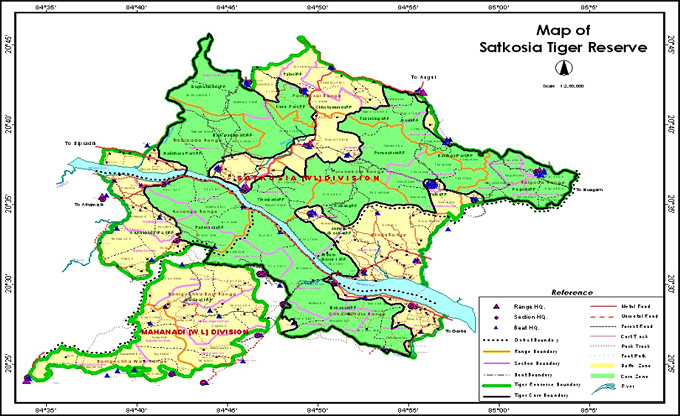Satkosia
Satkosia Tiger Reserve (STR) at its heart on either side of the river Mahanadi including the gorge portion was notified on December 31, 2007, comprising an area of 963.8 km2.

What does the name mean?
Satkosia derives its name from two words; sat (7) and kosa (mile), quantifying length of the gorge i.e. 14 miles or 22.4 kms.
Forest Type and Vegetation

The forest type is Tropical Deciduous Forest. Vegetation comprises Northern Tropical Moist Deciduous Forests and Moist Peninsular Low Level Sal Forest. Sal (Shorea robusta) and Teak (Dendrocalamus strictus) are the dominant tree species.
Three species of bamboo viz. Dendrocalamus strictus, Bambussa arundinaceae, Stephalostachyum pergacile are found in STR.
Tikarapada Crocodile Project
In 1974 Dr. H. R. Bustard, a FAO consultant to Govt. of India on crocodile first recommended conservation measures for Gharial (Gavialis gangeticus) in Satkosia, and started Crocodile Project in 1975 under his supervision. Subsequently, it was declared as a wildlife sanctuary on May 19, 1976.
Mahanadi Elephant Project

The charm of the Reserve is further enhanced with the presence of significant population of Asiatic Elephant (Elephas maximus) and comes under Mahanadi Elephant Reserve. The Elephant Reserve is declared in 2002. As per Orissa: Elephant Census Results, 2010, Satkosia Wildlife Division is the home to 224 individuals.
Satkosia Tiger Reserve
Owing to conserve declining population of tiger at international significance an area of 963.4 km2 spreading out over four districts i.e. Angul, Boud, Nayagarh, Cuttack, and two protected areas i.e. Satkosia Gorge Wildlife Sanctuary and Baisipali Wildlife Sanctuary of Odisha, Satkosia Tiger Reserve was declared in December 2007.
The reserve is abode to six adult tigers as per Wildlife Institute of India Census Report in 2006.
Location
85.35 to 86.5 East Longitudes
20.25 to 20.45 North Latitudes
Floral Diversity
Over 400 plant species comprising of 126 tree, 98 shrub, 125 herb and 51 climber species are identified from the reserve.
Hinjal (Baringtonia acutangula), Kochila (Strychnos nuxvomica), Rosewood (Dalbergia latifolia), Patal garuda (Roulfia serpentina), Gila (Entada phaseoloides), Mirigachara (Grewia elastica), Kangada (Xylia xylocarpa) and Patuli (Sterespermum chelonoides) are some threatened plant species found in Satkosia.
Faunal Diversity
Thirty eight species of mammals, 161 species of avifauna, 27 species of reptiles and 4 species of amphibians are identified from the reserve.
Besides the traditional home of two focal mammal species i.e. Royal Bengal Tiger (Panthera tigris) and Asiatic Elephant (Elephas maximus) the reserve is also refuge to Leopard (Panthera pardus), Dhole (Cuon alpinus), Striped Hyena (Hyaena hyaena), Sloth Bear (Melursus ursinus), Jungle Cat (Felis cheus), Wolf (), Jackle (), Chital, Sambar, Gaur, Barking Deer, Four Horned Antelope, Mouse Deer, Wild pig (Sus scrofa), Giant Squirrel (Ratufa indica).
Bird Species:
Satkosia identified as IBA as per report of Indian Bird conservation Network (IBCN) There are 164 bird species resides in satkosia Tiger Reserve.
ACTIVITIES & ACHIVEMENTS
Recognition and Awards
NEWS has received a number of recognition and awards for its environment and wildlife activities in the last five years. The notable awards are : Prakriti Mitra, Citations, shields , certificates and honours. The recognition as Honorary Wildlife Warden by the government of Orissa is remarkable as far as conservation of nature and wildlife is concerned.In addition to this, NEWS has also represented in various agencies like Important Bird Conservation Network (IBCN), Orissa Protected Area Network (OPAN) and Orissa Forest Conservation Network. Other government committees are also duly represented by the society.
